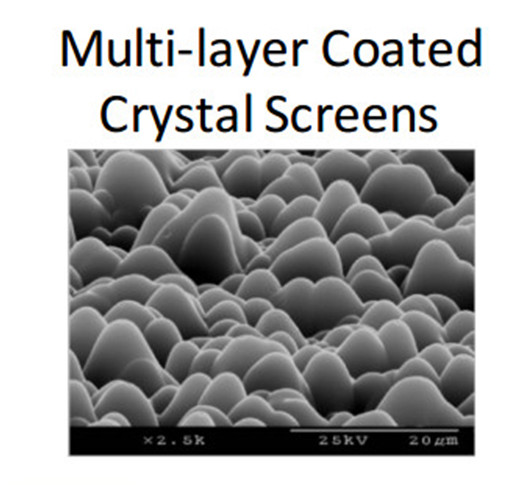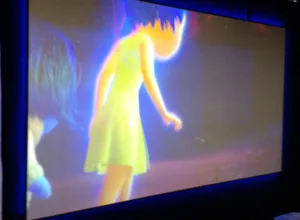There were a few new screen introductions at CEDIA which we summarize below.
Vutec introduced a new thin frame for their screen materials that is only 3/8” thick (9.5mm). It is targeted at commercial and residential applications and available up to 138” wide (350 cms). They also announced an LED option for their screens to allow LED lights to be placed around the edges of the screen. This has become a very popular item to add to the projection screen.
Draper had almost exactly the same news except their thin bezel option is ½” thick (12.7mm). It can be offered in sizes up to 30’ wide (9.15 M). Their LED option was also on display. These LEDs can offer different colors (see photo with blue LED glow around screen), but the colors are not coordinated with the content they way that the Philips Ambilight is.
Microlite Screen was showing its QuadVue screen, which they claim is the world’s first, true optical projection screen that is specifically designed for HDR. It is designed to repel ambient light using re-engineered ALR&plus (Ambient Light Rejection) technology with optical structure. QuadVue offers a 180 degree viewing angle horizontally and vertically as well with great flexibilty for projector and screen location.
ALR&plus Optical screen uses PET optical layers to deliver the ambient light rejection. It is claimed to enhance contrast by 100 times without using a black surface. Black screen material notoriously and dramatically dims images and when HDR content is turned on, the HDR will make the image even dimmer. With QuadVue there is no visible screen texture and it supports up to 20K resolution. It is offered in gains of 1.0 or 1.5 in screen sizes up to 132” in a 2.35:1 format.
Unfortunately, we did not get a chance to see this screen so can provide no comments on it.
Luminit was also at CEDIA showing its new screen technology and signing up new dealers. This new screen material was debuted at Display Summit and InfoComm (Luminit Reveals New Screen Technology) and uses a holographically defined nanolens structure to create their Crystal Screens. It offers excellent ambient light rejection, zero hot spots, wide viewing angle and high gain. A 16:10 screen was introduced at InfoComm, but a new 16:9 version launched at CEDIA.
Originally developed for the aerospace industry by optical scientists, Crystal Screens’ holographic technology creates a random surface that manipulates light energy. Unlike other screens where gain is reduced as the viewing angle increases, Crystal Screens provides a gain of 2.5 with a 120° viewing angle, making it an ideal screen for home theaters, media rooms, conference rooms, classrooms, and other environments where ambient light is difficult to control. Crystal Screens’ nanolens technology also preserves polarization effect so one screen can be used for both 2D and 3D viewing.
Designed and manufactured in Crystal Screens’ high-tech facility in Torrance, California, the fixed screens ship unassembled via UPS, reducing shipping costs and lead times. Other benefits include the ability to produce endless screen lengths with no seaming and excellent contrast and black levels in bright, dim or dark environments.
“Our patented technology is unique to Crystal Screens and cannot be duplicated,” said Dave Cusick, Director of Sales for Crystal Screens. “It will not be sold on-line and custom integrators will appreciate the performance, the quality and fast turnaround times that comes with designing and manufacturing in the United States.” – CC


